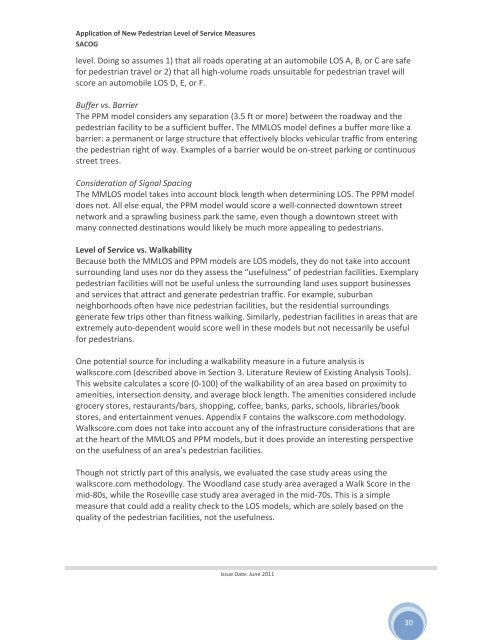Application of New Pedestrian Level of Service Measures - sacog
Application of New Pedestrian Level of Service Measures - sacog
Application of New Pedestrian Level of Service Measures - sacog
You also want an ePaper? Increase the reach of your titles
YUMPU automatically turns print PDFs into web optimized ePapers that Google loves.
<strong>Application</strong> <strong>of</strong> <strong>New</strong> <strong>Pedestrian</strong> <strong>Level</strong> <strong>of</strong> <strong>Service</strong> <strong>Measures</strong><br />
SACOG<br />
level. Doing so assumes 1) that all roads operating at an automobile LOS A, B, or C are safe<br />
for pedestrian travel or 2) that all high‐volume roads unsuitable for pedestrian travel will<br />
score an automobile LOS D, E, or F.<br />
Buffer vs. Barrier<br />
The PPM model considers any separation (3.5 ft or more) between the roadway and the<br />
pedestrian facility to be a sufficient buffer. The MMLOS model defines a buffer more like a<br />
barrier: a permanent or large structure that effectively blocks vehicular traffic from entering<br />
the pedestrian right <strong>of</strong> way. Examples <strong>of</strong> a barrier would be on‐street parking or continuous<br />
street trees.<br />
Consideration <strong>of</strong> Signal Spacing<br />
The MMLOS model takes into account block length when determining LOS. The PPM model<br />
does not. All else equal, the PPM model would score a well‐connected downtown street<br />
network and a sprawling business park the same, even though a downtown street with<br />
many connected destinations would likely be much more appealing to pedestrians.<br />
<strong>Level</strong> <strong>of</strong> <strong>Service</strong> vs. Walkability<br />
Because both the MMLOS and PPM models are LOS models, they do not take into account<br />
surrounding land uses nor do they assess the “usefulness” <strong>of</strong> pedestrian facilities. Exemplary<br />
pedestrian facilities will not be useful unless the surrounding land uses support businesses<br />
and services that attract and generate pedestrian traffic. For example, suburban<br />
neighborhoods <strong>of</strong>ten have nice pedestrian facilities, but the residential surroundings<br />
generate few trips other than fitness walking. Similarly, pedestrian facilities in areas that are<br />
extremely auto‐dependent would score well in these models but not necessarily be useful<br />
for pedestrians.<br />
One potential source for including a walkability measure in a future analysis is<br />
walkscore.com (described above in Section 3. Literature Review <strong>of</strong> Existing Analysis Tools).<br />
This website calculates a score (0‐100) <strong>of</strong> the walkability <strong>of</strong> an area based on proximity to<br />
amenities, intersection density, and average block length. The amenities considered include<br />
grocery stores, restaurants/bars, shopping, c<strong>of</strong>fee, banks, parks, schools, libraries/book<br />
stores, and entertainment venues. Appendix F contains the walkscore.com methodology.<br />
Walkscore.com does not take into account any <strong>of</strong> the infrastructure considerations that are<br />
at the heart <strong>of</strong> the MMLOS and PPM models, but it does provide an interesting perspective<br />
on the usefulness <strong>of</strong> an area’s pedestrian facilities.<br />
Though not strictly part <strong>of</strong> this analysis, we evaluated the case study areas using the<br />
walkscore.com methodology. The Woodland case study area averaged a Walk Score in the<br />
mid‐80s, while the Roseville case study area averaged in the mid‐70s. This is a simple<br />
measure that could add a reality check to the LOS models, which are solely based on the<br />
quality <strong>of</strong> the pedestrian facilities, not the usefulness.<br />
Issue Date: June 2011<br />
30
















